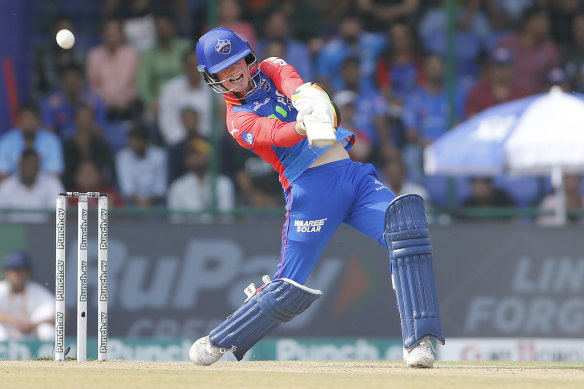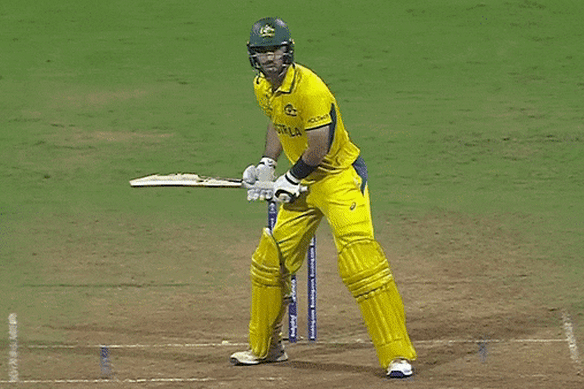Opinion
The joy of six has not been entirely lost, but it’s getting there
Greg Baum
Sports columnistHere’s a boring bit of cricket terminology: six.
Six used to have its own cachet, standing for a risk taken, a shot well and sometimes audaciously hit, a frisson in flight, some doubt about whether it would clear the fielders or the boundary, exultation when it did. Sixes were rare enough for each to be a landmark in a game.

Jake Fraser-McGurk has been devastating with the bat for the Delhi Capitals in the Indian Premier League.Credit: AP
But six has become the new two. And two is just about the most ho-hum score in cricket. It’s not a smartly taken single. It’s not three because threes don’t exist in Twenty20 cricket. And it’s not four or more. It doesn’t rotate the strike. Even when two is on, it’s usually baulked anyway.
Two is a mechanical, quotidian thing, a device to advance the score. Which is what six has become. Sixes happen along now at the rate twos once did. There were 42 in one match in the Indian Premier League the other day. They were like planes at Heathrow, flying over every couple of minutes.
They’ve been about 850 sixes in the IPL already this season, with a third of the tournament still to play out. That’s roughly 20 a match. Sunrisers Hyderabad are going at 12 a match by themselves. Jake Fraser-McGurk has hit 20 or them, or is it 50, or 35? It doesn’t matter. Never mind precision, feel the quantity. That’s how the IPL works.
But do you see what’s happening here? The fact of a six no longer matters; it’s the accumulation that counts. It’s not how or even what, it’s how many. The record for one IPL season is 1124 last year, and projections say it will be broken easily.

Glenn Maxwell slaps six more.Credit: Nine.
I blame Matthew Hayden. Twenty or more years ago, when he was mis-hitting sixes in front of the wicket, it became apparent that the game was up, and up, and up. A go-to of commentators who use terms like go-to is: “He didn’t get all of that.” The trouble is that now he doesn’t have to get all of it. He doesn’t need to get much of it at all.
Adam Gilchrist with his long swing and Glenn Maxwell with his backhand whacks at least had the decency to look like they were and are hitting sixes. Fraser-McGurk looks like he’s knocking in a new bat.
It’s not quite like that for everyone all the time, of course. The joy of six has not been entirely lost. Good batters sometimes muscle or improvise good balls for six, and that’s impressive. Maxwell’s the exemplar.
But more often, it’s just business. There’s little sense of weighing up in a split second risk, ability and reward. It’s that ball there, belted for six. If it doesn’t come off, there’s alway the next bloke, always tomorrow. It’s almost six and out, oh well.
There’s a trajectory here. Bats get bigger, forearms too. Grounds are made smaller, fielding restrictions tighter, the bowler’s target area contracts. The IPL now has an impact player, akin to baseball’s designated hitter, just in case not enough sixes are being hit. Doing is not enough, there must be overdoing.
It’s all of a piece with an ethos that seems to govern much sport now. Once, the saying was, when you’re on a good thing, stick to it. Now it is, when you’re on a good thing, load up on it, labour it and flog it until it collapses under its own weight. When it doesn’t work any more, get a new one. It works for computer games, so why not real ones?
It is one thing – an important thing – to refresh and reinvigorate a sport to stay in line with the times, another to indulge it to death.
What’s next? Here’s one thought, not mine or new: why call it six when you can make it 10? This was what English marketing man Stuart Dalrymple envisaged when he first anticipated and articulated what became the T20 revolution in cricket a quarter of a century ago. He thought this was how it would be by 2010, so we’re running behind schedule (but please don’t let the BCCI know).

A fan has a shoey at the watering hole during LIV Golf Adelaide.Credit: Getty
What’s after that? Well, LIV Golf has a watering hole, and if that means a participant occasionally gets hit in the head by a water bottle thrown by a drunkard and we all have to avert our eyes to the role of alcohol in the crisis of domestic violence that besets the country right now, that will have to be written off as collateral. You want more? Coming right up.
Eighty-odd years ago, the inimitable Neville Cardus wrote about a festival match at Scarborough. “A bowler bowls, the batsman makes a stroke, not a single fielder moves and the ball is returned from the boundary. The essence of any game is conflict. And there was no conflict here; the superiority on one side was too overwhelming.”
The batsman was Don Bradman. Substitute half the IPL roster for Bradman in Cardus’ snapshot, and you have T20 cricket now. That’s the trouble with the game: any old slogger can be made to look like Bradman. Like six becoming two, it’s a devaluation. Sixes are now like between-wars German currency: they come in wheelbarrows.
News, results and expert analysis from the weekend of sport sent every Monday. Sign up for our Sport newsletter.